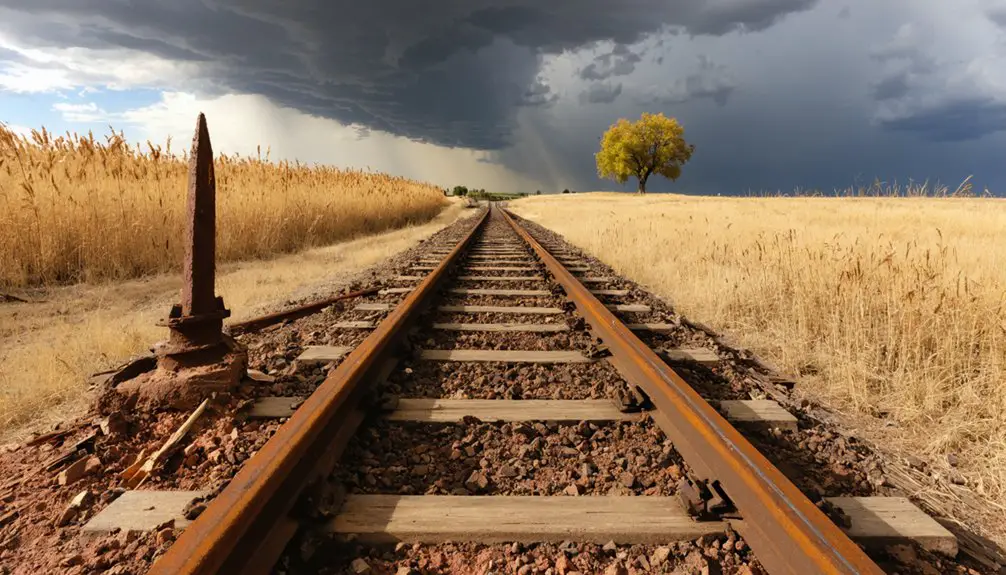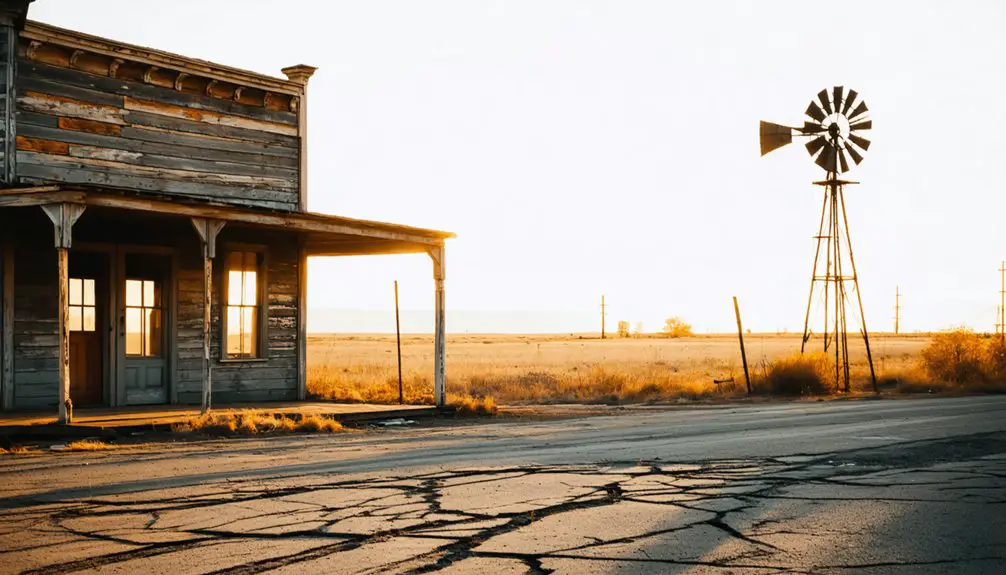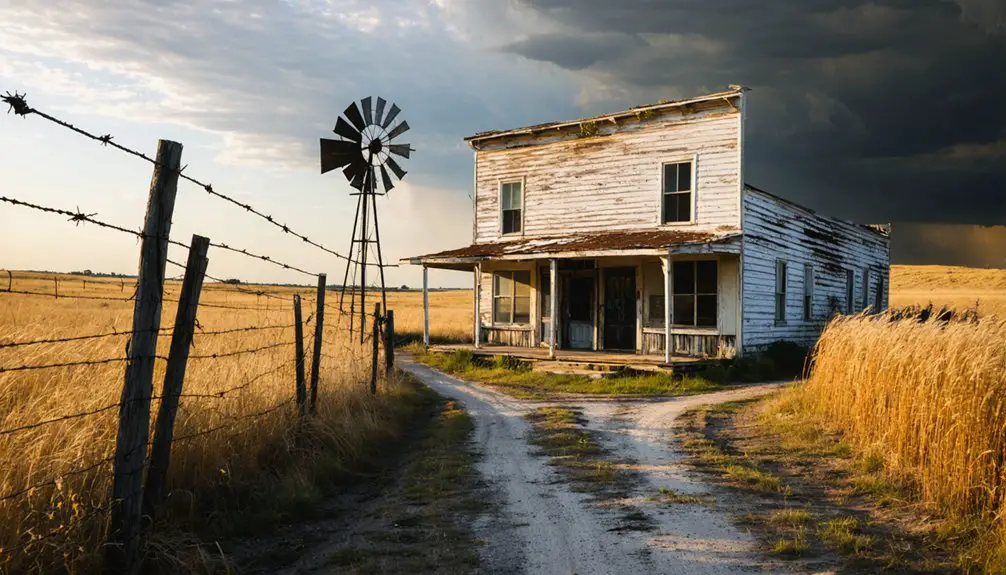You’ll find the ghost town of Ingalls in Oklahoma’s heartland, established during the 1889 Land Run as a promising frontier settlement. The town gained notoriety as a hideout for the Doolin-Dalton Gang before a deadly 1893 shootout with U.S. Marshals changed its fate forever. While a brief 1920s oil boom brought hope, today only two dozen families and scattered historic remnants mark this once-bustling community, where echoes of its wild past still linger.
Key Takeaways
- Ingalls, Oklahoma was established in 1889 during the Oklahoma Land Run and is now a ghost town with about two dozen families.
- The town became infamous as a hideout for the Doolin-Dalton Gang, culminating in the deadly Battle of Ingalls in 1893.
- Failed railroad connections and declining oil production in the 1920s led to Ingalls’ transformation into a ghost town.
- Historic remnants include the Ingalls Hotel, an old grocery store, and a monument honoring U.S. Marshals killed in 1893.
- The town’s original 16-block layout with wide streets remains visible, though most buildings have been dismantled or abandoned.
The Birth of a Frontier Town (1889)
During the historic Oklahoma Land Run of 1889, Dr. Robert F. McMurtry and Robert Beal staked their claim to establish the frontier settlement of Ingalls. Named after Kansas Senator John J. Ingalls, who’d championed legislation opening the Oklahoma Territory, the town quickly took shape with an ambitious 16-block layout featuring remarkably wide streets and alleys.
You’ll find that Ingalls’ early development was swift and purposeful. The founders laid out four east-west streets and four north-south thoroughfares, creating an organized grid that supported rapid community growth. The settlement flourished as a mail and supply center for the region’s agricultural community. The town established its post office in January 1890, marking a significant milestone in its development.
Wild West Outlaws Make Their Mark
The peaceful development of Ingalls took an unexpected turn when the notorious Doolin-Dalton Gang chose the town as their hideout in the early 1890s.
Led by Bill Doolin and Bill Dalton, this formidable group of outlaws, including “Bitter Creek” Newcomb and “Dynamite Dick” Clifton, transformed the quiet settlement into their personal sanctuary.
You’d find these outlaws, clad in their signature long dusters, frequenting local establishments like the Ransom Saloon.
Their outlaw tactics involved maintaining cordial relationships with townspeople while conducting daring bank and train robberies across multiple territories.
The gang dynamics worked in their favor as locals tolerated their presence, grateful for the criminals’ free-spending ways during tough economic times.
During hard times, townspeople overlooked the gang’s illegal activities, appreciating how freely they spent their ill-gotten gains.
The three U.S. Marshals lost their lives during the ensuing battle.
This symbiotic relationship would continue until the fateful Battle of Ingalls in 1893, when U.S. Marshal E.D. Nix led a raid against the gang during their poker game at the saloon.
The Deadly Battle That Changed Everything
On September 1, 1893, a devastating gunfight erupted in the streets of Ingalls when nine U.S. Marshals, led by E.D. Nix, confronted the notorious Doolin-Dalton Gang.
The outlaw legends had made this small Oklahoma town their safe haven, but ghostly whispers of that fateful day still echo through the abandoned buildings. A young boy spotted the approaching lawmen and warned the outlaws of the impending danger.
You’ll find the battle’s turning point at Vaughn’s Saloon, where three deputy marshals lost their lives. Deputy Marshal John Hixon engaged Bittercreek Newcomb in fierce initial gunfire.
“Arkansas Tom” Jones fired from a hotel window, while the gang’s local allies, including bartender Murray, joined the firefight.
Though the outlaws escaped that day, you’re walking through what became their last stronghold – the battle marked the beginning of the end for the Wild Bunch.
Every member would eventually fall to U.S. Marshals, leaving Ingalls to fade into a ghost town.
Life in Early Ingalls: A Community Takes Shape
Long before gunfire shattered its peace, Ingalls emerged from Oklahoma’s first land rush in 1889 as a promising frontier settlement, founded by Dr. Robert F. McMurtry and Robert Beal.
Named after Senator John J. Ingalls, the town’s community development followed an ambitious plan with 16 blocks featuring wide streets and convenient alleys.
You’d have found a bustling hub of commerce and activity, where nearly 150 residents built their dreams around a thriving agricultural economy. Like many towns bearing the English surname designation, Ingalls represented a new chapter in American frontier expansion.
The town’s early governance established essential services like a public well and school, while businesses flourished – from blacksmiths and boot shops to the two-story O.K. Hotel.
Despite facing challenges like land disputes and a missing railroad connection, Ingalls’ pioneering spirit prevailed through the early 1890s, creating a self-sufficient community where farmers and merchants prospered together.
The Doolin-Dalton Gang’s Reign
You’ll find that the Doolin-Dalton Gang controlled a vast territory spanning Oklahoma Territory, Kansas, Missouri, and Arkansas, with Ingalls serving as their primary stronghold.
Within this region, they executed meticulously planned bank robberies while maintaining a complex network of hideouts and escape routes centered around the sympathetic town of Ingalls. The gang’s infamous Battle of Ingalls on September 1, 1893 resulted in multiple casualties among lawmen and townspeople. Under Bill Doolin’s leadership, the gang earned a Robin Hood reputation among locals.
The gang’s relationship with Ingalls’ residents proved mutually beneficial, as the outlaws spent freely at local establishments like Murray’s Saloon while the townspeople provided them sanctuary from pursuing lawmen.
Gang’s Territory and Hideouts
During the early 1890s, the Doolin-Dalton Gang established their primary stronghold in Ingalls, Oklahoma Territory, a strategic location that served as both sanctuary and operational base.
You’ll find this town nine miles east of Stillwater, perfectly positioned for gang operations across Arkansas, Oklahoma, Kansas, and Missouri.
The outlaws maintained multiple strategic hideouts throughout Indian Territory, with Ingalls at the heart of their empire. The gang’s reach extended even further through Bill Dalton’s espionage, as he acted as their spy while avoiding direct involvement in robberies.
Murray’s Saloon became their gathering spot, while sympathetic locals provided shelter and warnings about approaching lawmen.
You’d have seen the gang stockpiling ammunition and supplies while planning their next heist.
Their “Robin Hood” reputation earned them protection from townspeople, who helped them evade capture during conflicts with marshals, including the infamous 1893 Battle of Ingalls.
Bank Robbery Operations
The Doolin-Dalton Gang’s bank robbery operations emerged from their Ingalls stronghold with methodical precision and daring strategy.
Their bank heist tactics involved swift daytime raids where gang members would storm in simultaneously, using intimidation and firearms to overwhelm staff and control access points. You’d find them forcing employees into vaults while others stood guard at entrances and escape routes.
The outlaws employed clever disguises, including false beards and mustaches, to delay identification. Each member played specific roles: some subdued bank staff, others secured exits, while leaders like Bob Dalton commanded operations inside.
They’d coordinate quick escapes through back alleys and pre-planned routes to hideouts in Indian Territory. Their most notorious attempt – the Coffeyville double bank robbery – proved fatal, effectively ending the gang’s reign.
Outlaw-Community Relations
While many frontier towns shunned outlaws, Ingalls stood apart as a sanctuary for the Doolin-Dalton Gang throughout the early 1890s.
You’ll find that outlaw tolerance flourished here, as the gang’s free-spending habits boosted the local economy. They frequented the town’s hotel and Ransom Saloon, maintaining a careful balance of power through selective good behavior.
The community’s complicity ran deep, with some residents actively warning gang members about approaching lawmen. This pragmatic alliance served both parties well – the outlaws gained a safe haven, while townspeople benefited from their protection and spending.
However, this delicate relationship shattered during the Battle of Ingalls in 1893, when federal marshals staged a bloody raid that left three deputies dead and several outlaws wounded.
Railroad Dreams and Broken Promises

Founded with high hopes in 1889 by Dr. Robert F. McMurtry and Robert Beal, Ingalls’s fate hinged on a promised railroad that would never come.
You’ll find that railroad significance in late 19th century Oklahoma couldn’t be overstated – it determined which frontier towns thrived and which withered away.
When major rail companies like the Atchison, Topeka & Santa Fe, Frisco, and Rock Island chose different routes, they sealed Ingalls’s economic decline.
The town initially served as a mail center and agricultural hub, but without rail access, it couldn’t compete with neighboring railroad towns.
As residents watched promised rail lines materialize elsewhere between 1897 and 1907, they began dismantling their homes and businesses, carrying away lumber and materials.
Ingalls became yet another victim of Oklahoma’s speculative railroad boom.
Black Gold Fever: The 1920s Oil Discovery
You’ll find the story of Ingalls’ oil boom beginning on March 12, 1920, when Mul-Berry Oil Co. struck black gold at 3,000 feet, producing up to 100 barrels daily.
The discovery sparked immediate excitement, bringing new residents, businesses, and even a dedicated post office named Signet to support the growing oil activity.
Initial Strike and Excitement
When the Mul-Berry Oil Company struck oil just east of Ingalls, Oklahoma on March 12, 1920, it sparked immediate excitement throughout the region. The oil discovery, found at 3,000 feet deep, yielded between 50 to 100 barrels per day, reviving hopes of prosperity in a town still haunted by its infamous 1893 shootout.
You’d have witnessed a community transformed by black gold fever, as celebrations erupted and a wave of optimism swept through the streets.
The strike couldn’t have come at a better time, as rising oil prices driven by America’s growing automobile industry fueled investment in exploration. This discovery instilled a deep sense of community pride, leading to the establishment of a new post office named Signet and triggering an influx of oil companies, workers, and support businesses to the area.
Community’s Brief Economic Revival
Shortly after the Mul-Berry Oil Company’s discovery, Ingalls experienced a dramatic transformation as oil companies and workers flooded the area. Initial wells produced between 50 and 100 barrels daily, fueling optimism about the town’s future as a major oil producer.
The economic impact quickly became apparent as new facilities emerged, including the establishment of Signet post office in 1921.
You’ll find that this oil boom sparked a significant shift in the community’s center, with businesses and residents gravitating toward the new Signet area, closer to the oil wells.
Despite local protests from Ingalls’ original residents, this migration reflected the powerful draw of petroleum prosperity. The revival brought newfound energy to a region previously known more for its troubled past than its economic potential.
Production’s Quick Fatal Decline
The euphoria of Ingalls’ oil discovery proved devastatingly brief.
You’d have witnessed a dramatic shift as the town’s promising oil boom, which started in 1920 with daily outputs of 50-100 barrels, spiraled into severe economic decline by 1925.
The swift depletion of oil reserves triggered an exodus of residents and businesses seeking fortune elsewhere.
A Town’s Fight for Survival
Despite early promise as a frontier settlement, Ingalls faced numerous challenges that threatened its survival from the start.
From its first days as a hopeful frontier outpost, Ingalls struggled against forces that would ultimately seal its fate.
You’ll find the town’s community resilience tested repeatedly – from the railroad’s devastating decision to bypass the settlement to the infamous Battle of Ingalls that drove many residents away. The town’s historical significance stems largely from its connection to the Doolin-Dalton Gang, though this notoriety ultimately hurt its prospects.
When oil was discovered in 1920, you might’ve thought Ingalls would bounce back. The Mul-Berry Oil Co.’s promising yields sparked new hope, even leading to a post office reopening under the name Signet.
But by 1925, production had plummeted. Despite residents’ fierce determination to maintain their community, the combined effects of isolation, economic instability, and dwindling population proved insurmountable.
What Remains: Modern-Day Ingalls

Walking through modern-day Ingalls, you’ll encounter a striking mix of historical remnants and sparse residential life. A handful of historic structures still stand, including the Ingalls Hotel and an old grocery store from the oil boom era.
While only about two dozen families now call this ghost town home, you’ll find both weathered buildings and newly constructed houses dotting the landscape. Modern residents, many descended from original settlers, maintain their connection to this historic site.
- The stone monument on Ash Street honors U.S. Marshals killed in the infamous 1893 battle
- Original building foundations mark the town’s former footprint
- The community building once served as Ingalls School
- An ancient firehouse stands as a symbol of frontier life
- Historical reenactments preserved local heritage until 2011
The Legacy of a Lost Oklahoma Settlement
Frontier dreams and harsh realities shaped Ingalls’ dramatic rise and fall as an Oklahoma settlement. Today, this ghost town stands as a monument to the untamed spirit of Oklahoma’s territorial era, where outlaws and lawmen clashed in deadly encounters.
You’ll find that Ingalls’ cultural heritage runs deep, from its overnight establishment during the 1889 Land Run to its notorious reputation as the Doolin-Dalton gang‘s hideout.
The 1893 battle between marshals and outlaws marked a turning point, driving many residents away. Though oil discoveries in 1920 briefly revived hopes, the boom’s decline sealed the town’s fate.
While most structures have vanished, stone foundations and historical markers remind you of this settlement’s complex legacy – a place where law and lawlessness collided, shaping Oklahoma’s frontier narrative.
Frequently Asked Questions
What Happened to the Original Buildings and Materials From Abandoned Ingalls Homes?
You’ll find most buildings weren’t preserved – residents dismantled and reclaimed materials, especially lumber, taking them to new locations for reuse due to high costs and material scarcity in the frontier.
Are There Any Living Descendants of the Original Ingalls Settlers?
You’ll find no confirmed living descendants through descendant research, as family histories weren’t well preserved. Most settlers dispersed after 1893, and those bloodlines likely merged into other Oklahoma communities.
Can Visitors Explore the Ghost Town Grounds Without Special Permission?
Like many ghost towns across Oklahoma, you can freely explore Ingalls’ grounds without special permission. Simply park near the historical markers and walk the publicly accessible areas to view foundations and monuments.
Were There Any Native American Settlements in the Ingalls Area Before 1889?
While Native tribes likely inhabited or traversed the area, you’ll find limited specific documentation of settlements. The land’s cultural significance stems from its status within Indian Territory before 1889’s land rush.
How Accurate Are the Historical Records of Daily Life in Ingalls?
Like scattered puzzle pieces, you’ll find historical documentation of daily life in Ingalls is quite limited. Records focus heavily on outlaw activity, while farming, domestic routines, and business operations remain poorly documented.
References
- https://www.kosu.org/arts-culture/2014-02-07/ghost-towns-ingalls
- https://pocketsights.com/tours/place/Ingalls-22577:2749
- https://www.visitstillwater.org/things-to-do/stillwater-area-history/the-doolin-dalton-gang-and-the-legacy-of-the-battle-of-ingalls/
- https://www.legendsofamerica.com/ok-ingallsgunfight/
- https://en.wikipedia.org/wiki/Ingalls
- https://www.historynet.com/ghost-towns-ingalls-oklahoma/
- https://okgenweb.net/~okpayne/documents/Ingalls Facts.pdf
- https://z94.com/battle-of-ingalls-oklahoma/
- https://en.wikipedia.org/wiki/Battle_of_Ingalls
- https://en.wikipedia.org/wiki/Wild_Bunch



